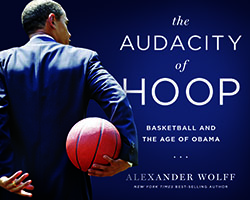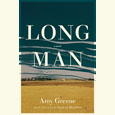A Way to Be Black in America
Alexander Wolff explores the relationship between Barack Obama and basketball
After securing the Democratic nomination during the 2008 presidential election, Barack Obama embarked on a world tour. When he visited Camp Arifjan in Kuwait, he spoke in a gymnasium, and then he drained a three-pointer. The soldiers roared, and the liberal voters back home mooned. Soon after that, a Republican attack ad called his shot disrespectful to the military. As Alexander Wolff describes in The Audacity of Hoop, basketball has served as a touchstone of Obama’s presidency, both enhancing his appeal and providing ammunition for critics. Moreover, basketball helps define Obama as a person—the sport offers insights into his character, contradictions, and charm.
 In 1971, Barack Obama Sr. gave his ten-year-old son a basketball for Christmas. The gift arrived during the only visit from his father that Barack Obama Jr. can recall, and given the president’s long search for own identity, that gift would take on enormous significance. Obama admired the cool style of the basketball players at the University of Hawaii, Wolff writes, and “this, he decided, was a world into which he wanted to fit his young self.” He grew obsessed with the sport. Basketball gave him a way to be black in America, despite having a white mother and a distant Kenyan father. Obama couldn’t crack the starting lineup of his high-school team, which won the state championship, and though he never seemed to shake that disappointment, he kept nurturing his passion for the game.
In 1971, Barack Obama Sr. gave his ten-year-old son a basketball for Christmas. The gift arrived during the only visit from his father that Barack Obama Jr. can recall, and given the president’s long search for own identity, that gift would take on enormous significance. Obama admired the cool style of the basketball players at the University of Hawaii, Wolff writes, and “this, he decided, was a world into which he wanted to fit his young self.” He grew obsessed with the sport. Basketball gave him a way to be black in America, despite having a white mother and a distant Kenyan father. Obama couldn’t crack the starting lineup of his high-school team, which won the state championship, and though he never seemed to shake that disappointment, he kept nurturing his passion for the game.
Whether he was a law student, community organizer, or politician, Obama found a way to connect with others through basketball. A good pickup game, like any grand political endeavor, needs to fuse individual talents with a communal goal. Neither flashy nor straitlaced, Obama adapted his style to the circumstances. Basketball reflected his overall pragmatism: “With its serial returns to equilibrium—cut backdoor against an overplay; shoot when the defense sags—the game represents Obama’s intellectual nature come alive,” Wolff writes.
As Obama’s political star rose, so did his association with basketball. Some of Obama’s inner circle grew out of his regular pickup game: Reggie Love, a close assistant to Obama from 2006 to 2011, once played on a national championship team at Duke, and Secretary of Education Arne Duncan was a star at Harvard. In one “cornerstone of the Obama creation myth,” Wolff writes, a young Barack Obama joined a game with Craig Robinson, a former star at Princeton. Craig reported back to his sister Michelle that her boyfriend was a solid, confident, unselfish player—good news for the future First Lady.
 During Obama’s historic run to the presidency, basketball shaped perceptions of the upstart candidate. His staff organized games with locals during the New Hampshire primary. He played H-O-R-S-E and three-on-three in basketball-mad Indiana. He stepped into a varsity scrimmage at the University of North Carolina, even driving into the lane on 6’9” star Tyler Hansbrough. NBA stars such as Kevin Garnett and Carmelo Anthony lent public endorsements. As Wolff writes, “the game had been his lifelong companion, and now, in the political fight of Obama’s life, it was pulling its weight.”
During Obama’s historic run to the presidency, basketball shaped perceptions of the upstart candidate. His staff organized games with locals during the New Hampshire primary. He played H-O-R-S-E and three-on-three in basketball-mad Indiana. He stepped into a varsity scrimmage at the University of North Carolina, even driving into the lane on 6’9” star Tyler Hansbrough. NBA stars such as Kevin Garnett and Carmelo Anthony lent public endorsements. As Wolff writes, “the game had been his lifelong companion, and now, in the political fight of Obama’s life, it was pulling its weight.”
To his devotees, Obama projected cool. Given the sport’s connection to African-American culture, basketball gave him an aura of authenticity, particularly amidst the racial idealism forged during his campaign. But basketball is also a truly American game that crosses lines of race and region, and so it counterweighed perceptions that Obama was somehow foreign, an outsider.
Obama’s “basketball jones” has at times been fodder for conservative critics. Karl Rove once characterized a disparaging remark Obama had made about a rival as “an unattractive carryover from his days playing pickup basketball at Harvard.” Wolff calls that crack “a Rove two-fer, a way to paint Obama as elitist and thug at the same time.”
As president, Obama has scrimmaged with NBA legends, coached his daughter’s youth team, used LeBron James and Kobe Bryant to recruit enrollees on HealthCare.gov, promoted his diplomatic objectives through appearances with international players, and staged an annual ESPN special where he picks his bracket for the NCAA tournament. During the years of his presidency, moreover, the NBA has not only surged in popularity but also harbored a new generation of politically outspoken athletes.
The Audacity of Hoop is a handsome, coffee-table book, richly illustrated with photographs of Obama both on and off the court. As noted by official photographer Pete Souza, Obama seems most at ease when playing or talking basketball, and such scenes deliver particularly compelling images of the president. Now on the dark side of fifty, Obama more often indulges his new fascination with golf, but basketball still helps to define him, and Wolff has artfully captured the intersection of politics, sport, and race through his presidency.

Aram Goudsouzian chairs the history department at the University of Memphis. His most recent book is Down to the Crossroads: Civil Rights, Black Power, and the Meredith March Against Fear.


